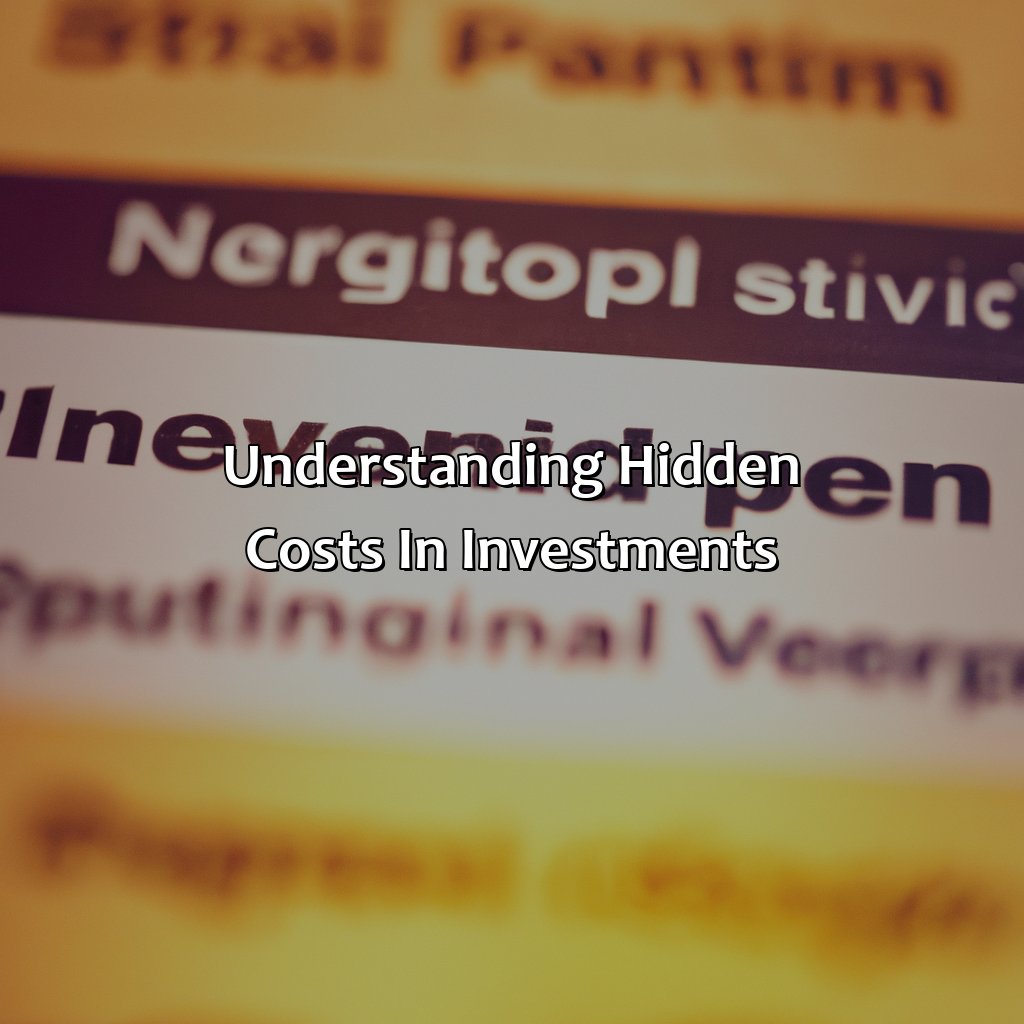Which Investment Might Have More Hidden Costs Than Others?
Key Takeaways:
- Hidden costs are an oft-overlooked factor in investments: While investors focus on potential returns and other benefits, they may overlook the hidden costs of an investment, which can significantly impact their bottom line over time.
- Some investments come with higher hidden costs than others: Mutual funds, exchange-traded funds (ETFs), variable annuities, and alternative investments are among those that may have more hidden costs than other investments. These costs can include fees, commissions, and expenses that may not be readily apparent to the investor.
- Avoiding hidden costs requires careful research and consultation: To avoid being blindsided by hidden costs, investors should research their investment options carefully, read the fine print, and consult with a financial advisor to ensure they understand all the costs associated with a particular investment.
Are you considering investing your money but unsure of which option might be the smartest? With so much information out there, it can be hard to decide which investment might have the most hidden costs. In this article, we’ll explore which types of investments have the most potential to cause financial headaches.
Understanding Hidden Costs in Investments
Investing has hidden costs. Get the scoop in our section called “Understanding Hidden Costs in Investments“. It has two sub-sections:
- “Definition of Hidden Costs“
- “Examples of Hidden Costs in Investments“
Dive in!

Image credits: retiregenz.com by Yuval Arnold
Definition of Hidden Costs
Investments often come with additional expenses, which may not be transparent to investors. Such expenses are hidden costs that can significantly reduce investment returns. Hidden costs vary based on the type of investment and can include transaction fees, management fees, bid-ask spreads and taxes. These costs are usually not included in the stated rate of return for an investment. Consequently, it is crucial to understand which investments may have more hidden costs than others.
For example, mutual funds often impose a range of hidden fees such as 12b1 fees and loads that can drastically affect the return on investment. Additionally, alternative investments like private equity or hedge funds may carry hidden expenses such as liquidity or lockup premiums, making them appear more profitable than they are. ETFs often have lower management fees compared to other investments but come with trading commissions and bid-ask spreads that can increase costs over time.
To make informed decisions about where to invest their money and maximize their returns potential, investors must carefully scrutinize the fees listed in an investment’s prospectus and invest accordingly.
In the past, several high-profile lawsuits have been filed by investors against fund managers for excessive “hidden” fees charged without appropriate disclosure. These legal battles helped shed light on how obscurely fund managers were treating these “hidden charges”. It continues to highlight the importance of knowing about these types of charges before choosing to invest in a particular product or instrument.
Hidden costs in investments are like ghosts – you never see them coming until it’s too late.
Examples of Hidden Costs in Investments
Investment often comes with hidden charges that can eat away at your returns and affect long-term gains. These undisclosed costs are often not transparent and difficult to spot initially, making them a crucial factor in investment planning. Here are six points on some hidden costs that can impact your investments:
- Trading fees
- Mutual fund expense ratios
- Administrative expenses
- Taxes
- Exit fees or early withdrawal penalties
- Performance drag: Charges from active management when compared to passive index funds.
It is vital to be aware of these costs to make informed investment decisions. Tax implications may vary depending on country regulations and the type of investment. Understanding administrative expenses such as transaction costs, account opening, and maintenance fees will help you manage your investments better.
Pro Tip: Always read the fine print and ask for clarification on any ambiguous terms before investing in an opportunity.
Be careful with investments that have more hidden fees than a Da Vinci Code treasure hunt.
Investments with More Hidden Costs
Uncover investments that could contain hidden expenses. Take a look at the “Investments with More Hidden Costs” section. This covers mutual funds, exchange-traded funds (ETFs), variable annuities, and alternative investments. Not just the transactional fees, but other hidden fees too. Learn what these could be.

Image credits: retiregenz.com by Yuval Arnold
Mutual Funds
When it comes to pooled investment funds governed by asset managers, there are certain investments with more undisclosed fees. Mutual funds, for instance, are the most popular and usually comprise a significant part of an investor’s portfolio. They are regulated by federal securities laws and own a wide range of stocks from diverse industries. However, when investing in mutual funds, it is important to remember that they come with hidden expenses that eat into returns, such as management fees and 12b-1 marketing charges. These costs affect investors’ overall returns.
In addition, investors should be aware of the expense ratio. This ratio represents the percentage of fund assets taken out in management expenses each year. Higher expense ratios can significantly diminish returns on invested capital over time. Also, investors who sell their shares in a mutual fund too soon could face early redemption fees.
It should be noted that while mutual funds offer professional management and diversification benefits; potential expenses can impact returns. Therefore, these costs must be factored into any investment decision concerning mutual funds.
Finally, there have been cases where mutual fund managers have been sued by investors for excessive fees. In one case where Morgan Stanley was sued for exceedingly high retirement plan fees over five years -they agreed to pay $3.3 million as restitution for the settlement.
ETFs may have lower expenses, but don’t forget to factor in the cost of constantly refreshing your investment app to check on them.
Exchange-Traded Funds (ETFs)
Investing in publicly traded baskets of securities, Exchange-Traded Funds (ETFs) resemble mutual funds that track the performance of a chosen index. ETFs tend to have lower expense ratios, making them an attractive investment. However, investors should be aware of the hidden costs such as bid-ask spreads and brokerage commissions, which could potentially eat into their profits.
Moreover, some ETFs could be structured differently and require monitoring for tracking errors or other risks associated with their unique structures. As such, investors should carefully scrutinize investment objectives and assess associated risks to determine if the investment is suitable for their portfolio.
It is vital to be well-informed about all possible costs and intricacies before investing in ETFs. Those who overlook this information may potentially lose out on higher returns from unseen expenses and face risk from hidden complexities. Act diligently in your investments to avoid FOMO (fear of missing out) on profitable returns while being mindful of the potential pitfalls that come with risky investments like ETFs.
Variable annuities are like a game of Russian Roulette, except instead of bullets, you’re spinning a wheel to see how much you’ll lose in fees.
Variable Annuities
Variable annuities are investment products that offer clients a range of investment options combined with an insurance component. These investments are more complex than traditional annuities and carry higher fees and expenses, which can be hard to discern. Some additional hidden costs might include:
- Mortality and expense risk fees
- Administrative fees
- Contract-related charges
Moreover, variable annuity providers may charge clients with penalty payments for early withdrawals or surrendering the policy altogether before maturity. It is important to read the fine print in these contracts to understand all the conditions before signing up.
If you are considering investing in this type of product, seek advice from a trusted financial advisor who can explain clearly how it fits into your overall portfolio and goals. Ignoring hidden fees could lead to significant loss over time.
Don’t miss out on understanding the implications of hidden costs in variable annuities – consult a professional today!
Looking for an investment that will make you feel like a rebel? Alternative investments may be the way to go, just be prepared for some unconventional hidden fees.
Alternative Investments
As investors seek greater returns and portfolio diversification, they explore “unconventional” assets like private equity, real estate, hedge funds etc., known as non-traditional or diversified investments. Such Alternative Investments carry costs that aren’t apparent in traditional investments and can be difficult to quantify accurately. The lack of transparency increases the risk of unwarranted charges.
Many alternative asset classes charge higher fees, offer lower liquidity, have limited regulation by authorities and also involve heightened tax complexities – which indicate higher hidden expenses. Other potential unwanted costs include capital call payments, phantom income gains or losses on financial statements. These expenses may erode an investor’s returns over time compared to more conventional investments.
Alternative Investments are widely accepted today as an essential alternative to traditional investments when it comes to securing wealth for the long-term. However, these types of investments need deeper attention when assessing costs. A proactive approach is essential rather than follow popular marketing tactics from few intangible investment firms.
Pro Tip: Before investing in any Alternative Investment, research explicitly its risks, opportunities and the associated actual cost with a knowledgeable advisor/coach who knows how to incorporate them into your financial plan accordingly.
Want to avoid hidden costs in investments? Just pretend you’re Sherlock Holmes and scrutinize every small detail, even if it means losing a few hours of sleep.
Avoiding Hidden Costs
To dodge hidden costs in your investments, tackle it with the “Avoiding Hidden Costs” section. Research investment options, read the fine print, and consult a financial advisor. These sub-sections will assist you in making smart decisions. They’ll also reduce risk and maximize returns on your investments.

Image credits: retiregenz.com by Adam Woodhock
Researching Investment Options
Finding Prospective Investable Opportunities
Investors are always on the lookout for opportunities that can result in increased wealth. Researching investable options is critical to ensure informed decision-making when selecting which investment option to pursue. Understanding what differentiates one investment from another is crucial in avoiding unseen costs that could impact returns.
When researching potential investments, it’s essential to start with a clear understanding of your financial goals and risk appetite. The next step involves conducting comprehensive research on prospective investments, analyzing market trends, and consulting with financial experts. By doing so, you can develop a deeper understanding of the risks involved, any hidden costs associated with a particular investment, as well as the potential for future returns.
It’s important to note that investments such as mutual funds and exchange-traded funds (ETFs) often come with less hidden costs than other alternatives like hedge funds or private equity funds. Understanding the differences between these options is essential for developing an effective investment plan.
A few years back, one of my colleagues invested his life savings into a long-term stock option without conducting significant research on prospective investments and various types of stocks available to him. It resulted in huge losses due to unforeseen hidden charges imposed by the brokerage firm he had used.
This story underlines why investors need to conduct thorough research before investing their hard-earned money into stocks or any other form of investments blindly. The key takeaway here is that proper research plays an important role in identifying those hidden costs while also helping select the best possible long-term investment based on individual goals and risk appetite.
Reading the fine print is like trying to decipher a secret code, except the only reward is avoiding financial ruin.
Reading the Fine Print
Exploring the Intricacies of Contractual Obligations
Investing can come with hidden costs, but it’s essential to ‘read between the lines’ when examining an investment contract. Small print details may significantly affect long-term investments, so highlighting hidden clauses and charges is fundamental. These terms are typically out of sight as they appear in obscure paragraphs or use unfamiliar legal jargon.
Ensure Clarity & Understanding
Understanding contractual obligations is vital, as investors can unknowingly assume unwanted risks or limitations resulting from complicated terminology. It’s imperative to seek advice and related information before making any significant investment decisions to harness a comprehensive perspective from unbiased investment professionals. This increases transparency while managing expectations and avoiding unpleasant surprises.
Stay Diligent & Focus on Objectives
It’s crucial to read and observe each detail of a contract since even minor variations can cause increased fees or confusion mid-way through investments, causing misinterpretations later on. A comprehensive understanding of these details will lead to a crystal-clear comprehension of realistic goals, management protocols, potential growth avenues, all culminating in well-informed decision-making about investing your assets.
Pro Tip: Engage with trusted companies that prioritize transparent communication and provide explicit answers about contractual obligations without any ambiguity for more robust investment outcomes.
Don’t consult a financial advisor unless you want to know what it feels like to pay hidden costs for advice you didn’t even know you needed.
Consulting a Financial Advisor
Seeking Professional Advice for Investment Decisions
Finding expert advice can help you avoid the hidden costs that often accompany investments. Advisors have extensive knowledge of the market and can provide valuable insight into which investments will best suit your goals and budget requirements. By understanding your risk tolerance, they can help you develop a clear investment strategy. With access to their resources, you are likely to make better-informed decisions.
It is essential to choose an advisor who aligns with your values and understands your goals. Some may charge a flat rate for their services, while others work on commission or fee-based structures, so be sure to understand their payment policy before committing. It’s also important to note that advisors’ credentials vary widely – seek an advisor with certification from reputable organizations such as CFA Institute or ICPM.
Investors without financial expertise can easily overlook critical information when making investment decisions alone; therefore, consulting with qualified professionals creates a stronger investment plan, reducing risks that could cause loss of capital in the long run.
Did you know Warren Buffet’s net worth was 40% higher than what it stands today if he had consulted an advisor on tech stocks? Seeking professional advice can prevent costly errors.
Five Facts About Investments With Hidden Costs:
Mutual funds and ETFs may have hidden fees, such as expense ratios and trading costs. (Source: Investopedia)
Annuities can have high fees and surrender charges, as well as complex provisions and restrictions. (Source: FINRA)
Variable annuities often come with riders that may add extra fees, such as optional benefits or income guarantees. (Source: The Balance)
Some investment advisors may charge hidden fees, such as performance fees or soft dollars. (Source: Forbes)
Hedge funds may have high management and performance fees, as well as limited liquidity and transparency. (Source: Investopedia)
FAQs about Which Investment Might Have More Hidden Costs Than Others?
Which investment might have more hidden costs than others?
Investing can come with various costs—some are overt and some are hidden. Certain types of investments are more costly than others, with some expenses being more apparent than others. However, some investments have more hidden costs than others. Listed below are some frequently asked questions about it:
What are hidden costs associated with investment?
Hidden costs in investment commonly referred to as fees that aren’t readily visible. Some examples of hidden costs include Expense ratios, Commission Fees, Financing Costs, Cash Flow Constraints, and Trade Execution Costs which cause serious harm to your investment returns.
What type of investments tend to have more hidden costs?
Some types of investments may have more hidden costs than others. For instance, some mutual funds and exchange-traded funds (ETFs) may have higher hidden costs, whereas Index funds generally have naturally lower expense ratios that cut down the expenses involved with investing.
What are the best ways to identify hidden costs in investment?
The most reliable way to identify hidden costs associated with investing is to read the fine print for an investment product or consult a qualified financial advisor. Another way is to review the prospectus known as a legal document that provides information about the management team, fees involved, purchasing times and terms, and any additional requirements for purchasing.
How can hidden costs impact my investments?
Hidden fees might be disadvantageous for investors if they cut their return on investment, resulting in a loss over an extended period. As a result, the long-term value of an investment that charges high hidden fees might be reduced substantially.
Are all hidden costs associated with investment bad?
Not always. There may be instances where investment options with hidden fees are still suitable for investors and can be beneficial. But investors should always be aware of the hidden costs by reading the fine print or consulting a financial advisor before investing.
 Checkout this IRS Loophole
Checkout this IRS Loophole 
